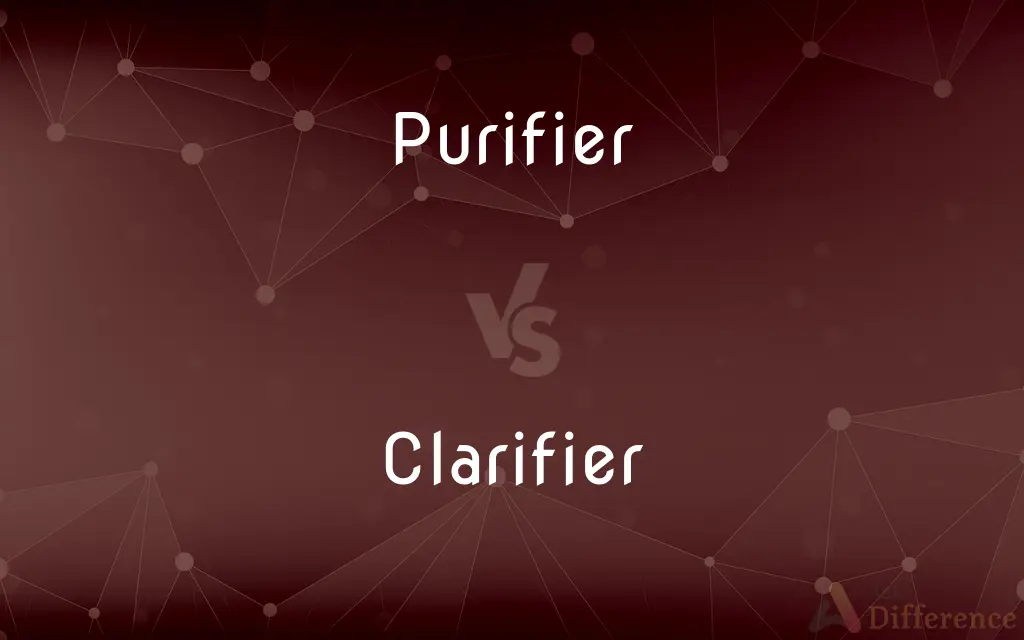Purifier vs. Clarifier — What's the Difference?
By Urooj Arif & Maham Liaqat — Updated on March 20, 2024
Purifiers separate impurities from substances, like air or water, using filters or chemical processes, whereas clarifiers mainly remove sediment and particles through settling or coagulation.

Difference Between Purifier and Clarifier
Table of Contents
ADVERTISEMENT
Key Differences
Purifiers are designed to remove various types of impurities, including microscopic particles, bacteria, and gases, from substances like air or water. They often use filters, UV light, or chemical processes to achieve purification. On the other hand, clarifiers primarily focus on removing suspended solids and particulate matter from liquids. They typically work through the processes of sedimentation, where particles settle at the bottom, or flocculation, where particles clump together and then settle.
While purifiers are used in a wide range of applications from household water and air purifiers to industrial gas purification, clarifiers are commonly found in wastewater treatment plants, drinking water treatment facilities, and in some industrial processes involving liquids. The goal of a purifier is to make the substance as clean and free from impurities as possible, which can involve removing very small or dissolved substances. In contrast, clarifiers aim to make the liquid clearer by reducing turbidity, which involves removing larger, suspended particles.
Purifiers can be critical in environments where the purity of air or water is essential for health and safety, such as in hospitals, laboratories, and homes in areas with polluted outdoor air or contaminated water supply. Clarifiers, while also important for health and safety, are more often associated with large-scale processes like treating the vast amounts of wastewater produced by communities or industrial processes before releasing it back into the environment.
The technology and methods used in purifiers can vary widely, from simple charcoal filters to complex systems involving reverse osmosis or advanced oxidation processes. Clarifiers, however, usually rely on relatively simple physical processes, although they may also include chemical treatments to enhance coagulation and flocculation.
Both purifiers and clarifiers play crucial roles in maintaining environmental health and ensuring the safety of drinking water and breathable air. However, the specific technologies and methods they employ are tailored to their unique purposes - purifiers for removing a wide range of impurities to a high degree of purity, and clarifiers for removing larger particulate matter to improve clarity and reduce turbidity.
ADVERTISEMENT
Comparison Chart
Purpose
Removes various impurities to achieve high purity
Removes suspended solids to improve clarity
Primary Function
Filters, absorbs, or chemically transforms impurities
Settles or coagulates particles to remove them
Application
Air and water purification in homes, industries, labs
Wastewater and drinking water treatment, industrial use
Technologies
Filters, UV light, reverse osmosis, oxidation
Sedimentation tanks, flocculation agents
Focus
Broad range of impurities including microscopic
Larger, suspended particulate matter
Compare with Definitions
Purifier
Used in water treatment.
The water purifier in my kitchen uses reverse osmosis to ensure our drinking water is safe.
Clarifier
Uses gravity for separation.
Gravity clarifiers are common in water treatment, relying on sedimentation.
Purifier
Device that removes contaminants.
An air purifier can remove up to 99.97% of airborne pollutants, including pollen and dust.
Clarifier
Settles suspended solids.
The wastewater treatment plant's clarifier allows solids to settle out of the water before discharge.
Purifier
Can involve chemical processes.
Some purifiers use activated carbon to chemically bind and remove impurities.
Clarifier
May include chemical coagulation.
Adding coagulants in a clarifier helps particles clump together and settle faster.
Purifier
Varied applications.
Industrial purifiers are essential in pharmaceutical manufacturing to ensure product purity.
Clarifier
Primarily for liquid treatment.
Clarifiers are integral to the process of cleaning municipal drinking water.
Purifier
Can target microscopic particles.
HEPA filters in air purifiers are effective against particles as small as 0.3 microns.
Clarifier
Improves liquid clarity.
A clarifier in the brewery ensures the beer is crystal clear by removing particulates.
Purifier
To rid of impurities
Purify water.
Clarifier
Clarifiers are settling tanks built with mechanical means for continuous removal of solids being deposited by sedimentation. A clarifier is generally used to remove solid particulates or suspended solids from liquid for clarification and/or thickening.
Purifier
To rid of foreign or objectionable elements
Tried to purify the party of its dissenters.
Clarifier
To make clear or easier to understand; elucidate
Clarified her intentions.
Purifier
To free from moral or spiritual defilement
Rituals to purify the soul.
Clarifier
To clear of confusion or uncertainty
Clarify the mind.
Purifier
A person or device that purifies (by removing impurities)
Clarifier
To make clear by removing impurities or solid matter, as by heating gently or filtering
Clarify butter.
Purifier
One who, or that which, purifies or cleanses; a cleanser; a refiner.
Clarifier
To become clear.
Purifier
An apparatus for removing impurities
Clarifier
One who, or that which, clarifies.
Clarifier
(linguistics) A speech act intended to clarify or correct one's own prior utterance.
Clarifier
A vessel in which the process of clarification is conducted.
Clarifier
(cartomancy) An additional card used to enhance or explain the primary cards in a spread.
Clarifier
That which clarifies.
Clarifier
A vessel in which the process of clarification is conducted; as, the clarifier in sugar works.
Common Curiosities
Can purifiers remove viruses?
Yes, some purifiers, especially those with HEPA filters or UV light, can effectively remove or inactivate viruses.
What technologies are used in purifiers?
Purifiers may use a variety of technologies, including physical filters, chemical adsorption, UV light, and reverse osmosis.
What is the main function of a purifier?
A purifier's main function is to remove a wide range of contaminants, including microscopic particles and gases, from substances like air or water.
How does a clarifier work?
A clarifier works by allowing suspended solids to settle to the bottom or by causing them to clump together into larger particles that settle more easily.
What role do coagulants play in clarifiers?
Coagulants help particles in the liquid to aggregate into larger clumps, making them easier to settle and remove in a clarifier.
Are clarifiers used in air treatment?
Clarifiers are primarily used for liquid treatment, such as in wastewater and drinking water, and are not typically used for air treatment.
What is the difference in the scale of operation between purifiers and clarifiers?
While both can operate on various scales, clarifiers are often associated with larger-scale operations like municipal water treatment, whereas purifiers can be found in both large-scale and smaller, personal use cases.
What is a common use for air purifiers?
Air purifiers are commonly used in homes and offices to remove allergens, dust, and pollutants, improving indoor air quality.
How does the removal of impurities differ between purifiers and clarifiers?
Purifiers can remove a broader range of impurities, including dissolved substances and microscopic particles, whereas clarifiers mainly remove suspended solids and larger particles.
How important is maintenance for purifiers and clarifiers?
Regular maintenance is crucial for both to ensure they continue to operate effectively and prevent clogging or other issues.
Can clarifiers remove chemicals from water?
Clarifiers are not designed to remove dissolved chemicals; they primarily remove particulate matter.
Can a purifier and clarifier be used together?
Yes, in some water treatment processes, a clarifier might be used first to remove larger particles, followed by a purifier for finer purification.
What makes a purifier different from a filter?
A purifier often includes a filter as part of its system but may also use additional technologies or processes to remove or neutralize impurities.
Share Your Discovery

Previous Comparison
Demotivated vs. Unmotivated
Next Comparison
Unquilted vs. QuiltedAuthor Spotlight
Written by
Urooj ArifUrooj is a skilled content writer at Ask Difference, known for her exceptional ability to simplify complex topics into engaging and informative content. With a passion for research and a flair for clear, concise writing, she consistently delivers articles that resonate with our diverse audience.
Co-written by
Maham Liaqat













































